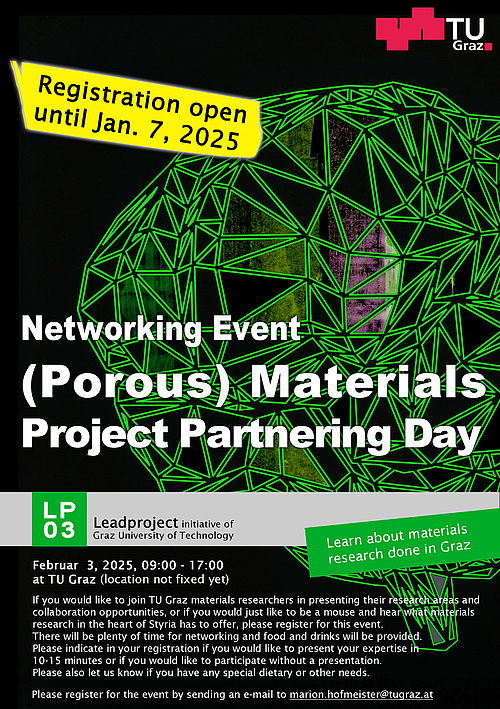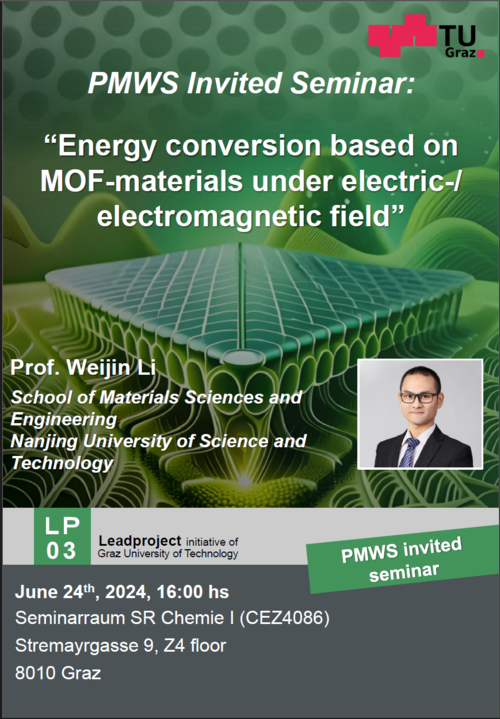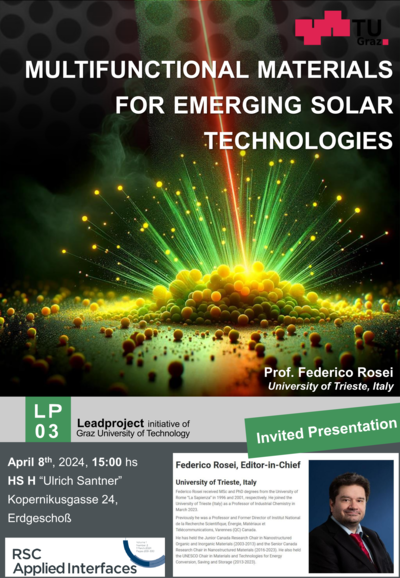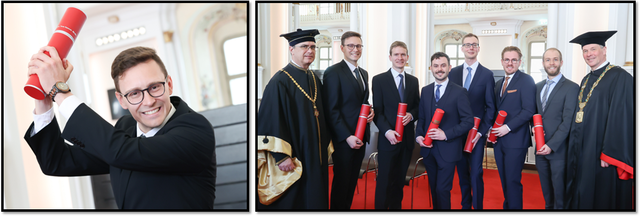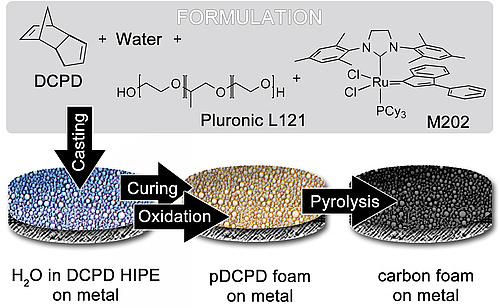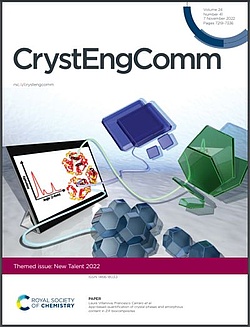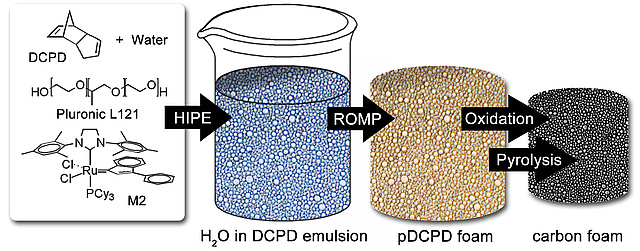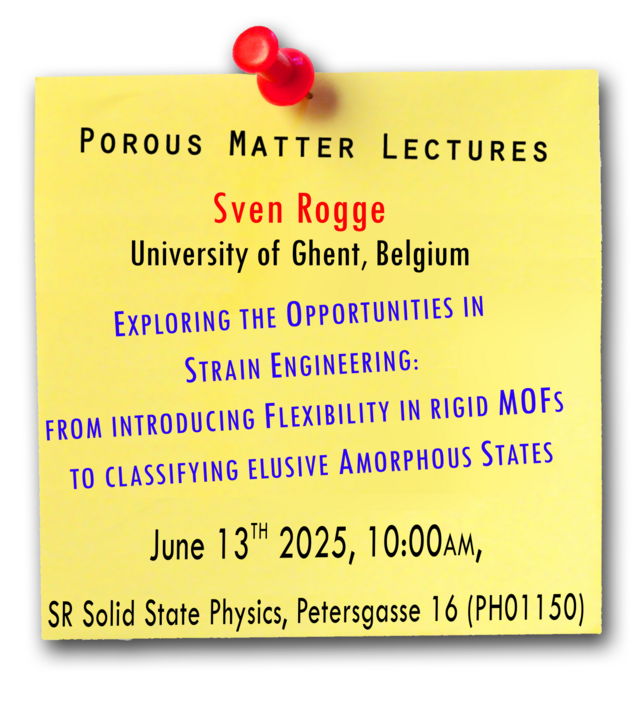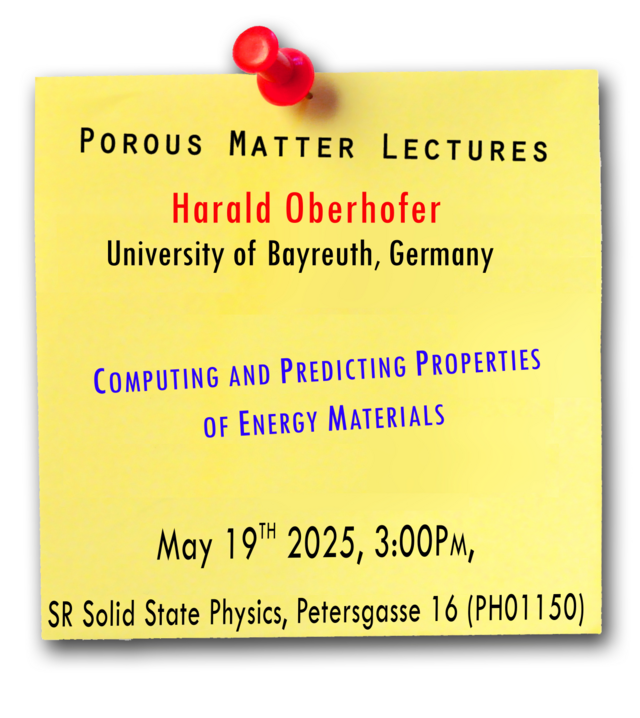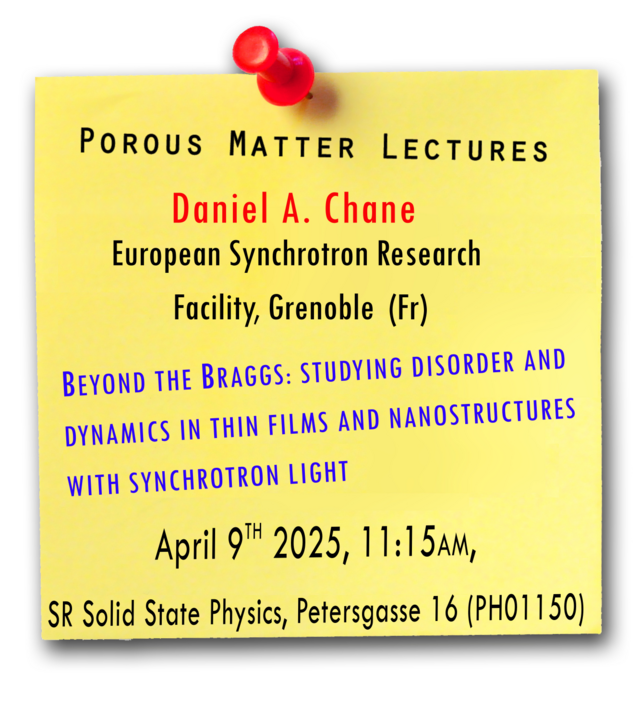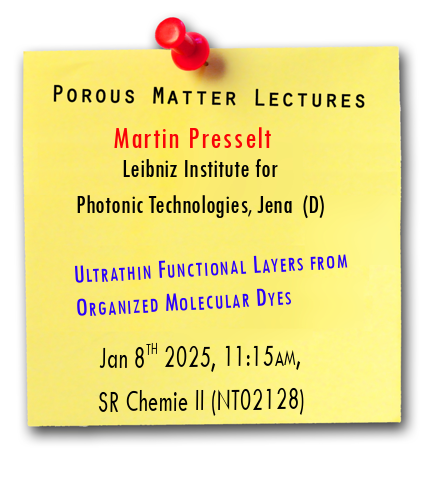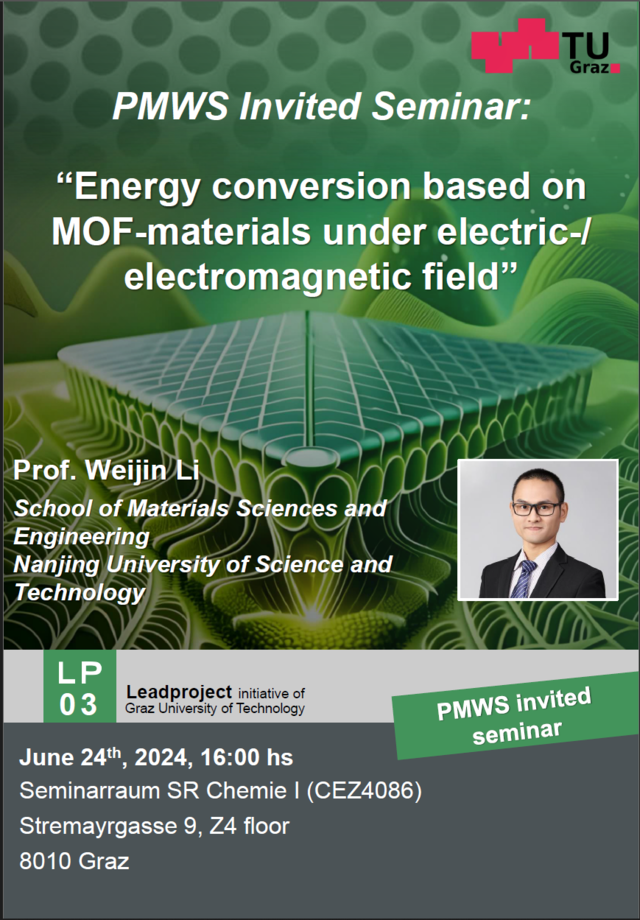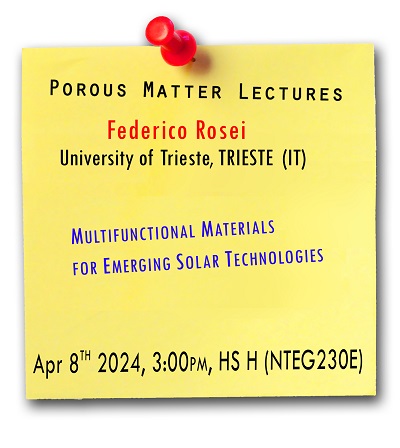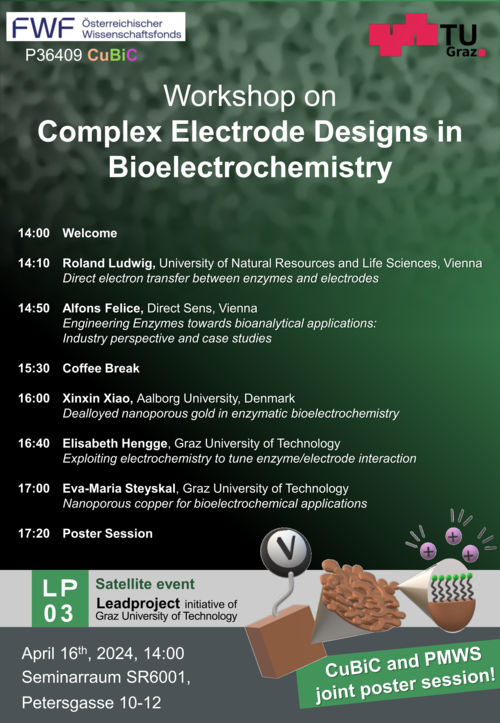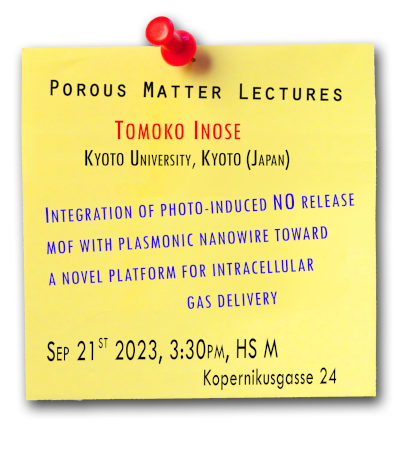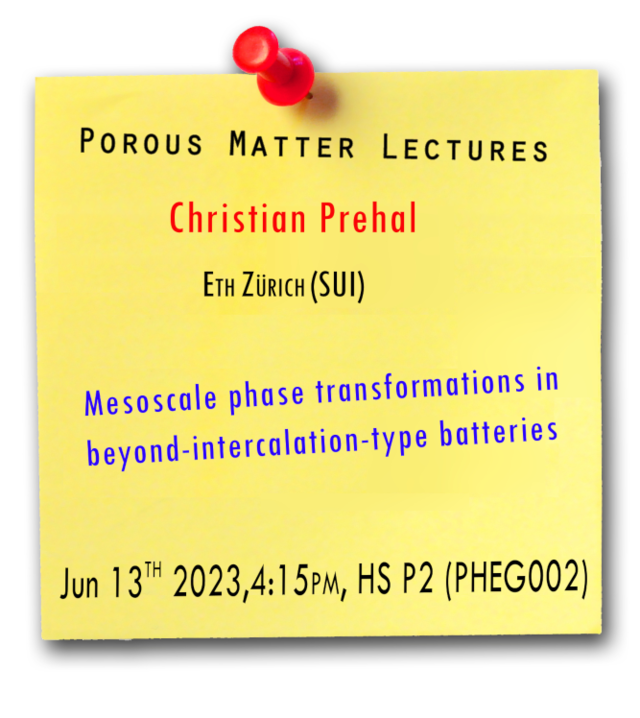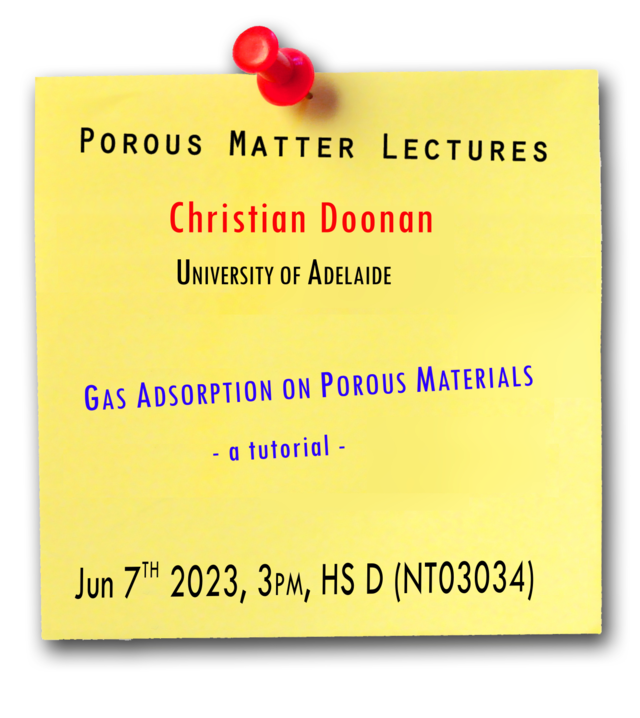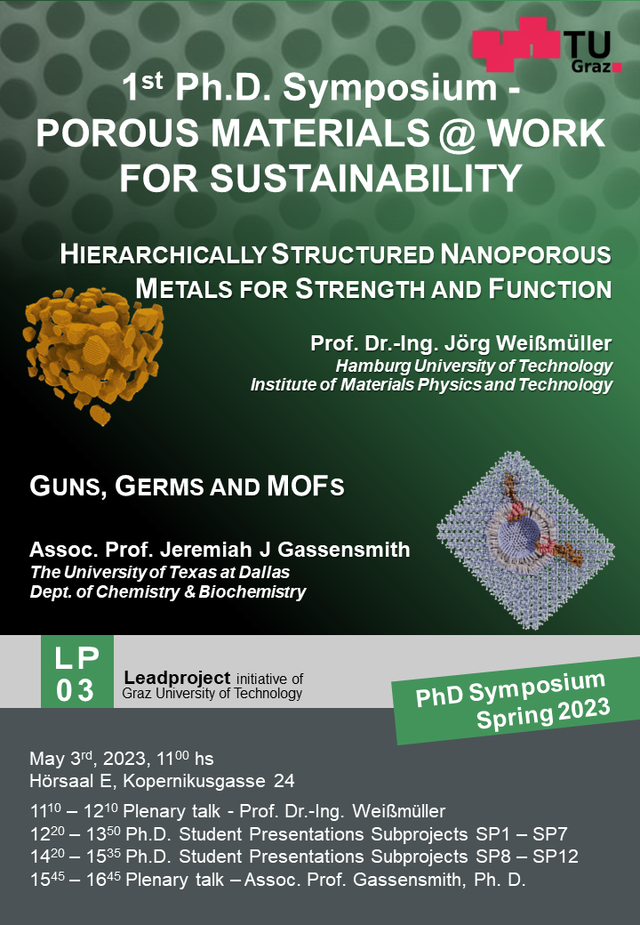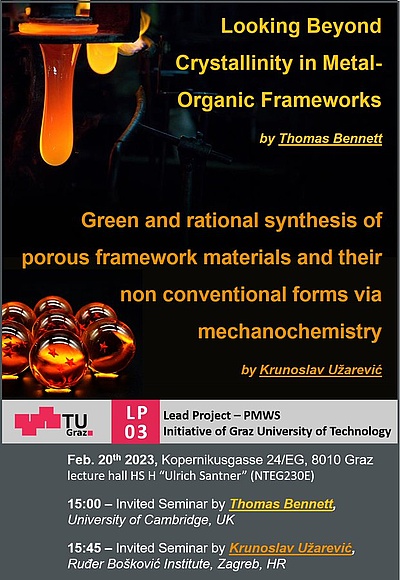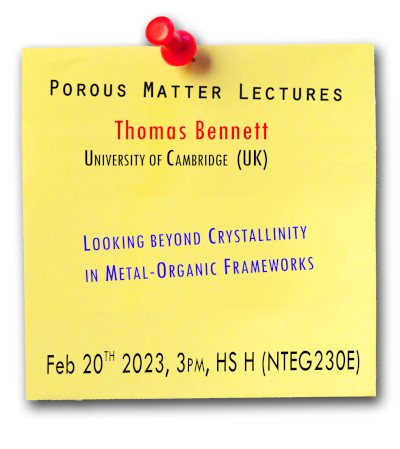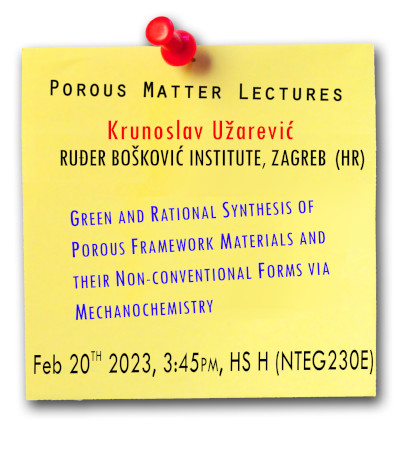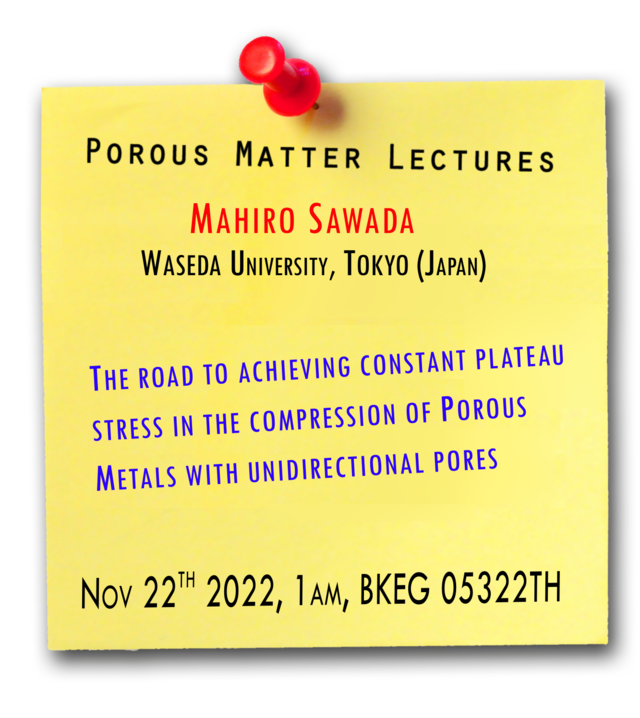

We welcome Sven Rogge (University of Ghent) with his presentation
"Exploring the opportunities in strain engineering: From introducing flexibility in rigid MOFs to classifying elusive amorphous states”.
Wednesday, June 13th, 2025, 10:00 AM
Venue: SR Solid State Physics (PH01150), Petersgasse 16, 1st floor, Graz University of Technology
Abstract: TBA

We welcome Harald Oberhofer (Chair for Theoretical Physics VII, University of Bayreuth) with his presentation
"Computing and Predicting Properties of Energy Materials”.
Wednesday, May 19th, 2025, 3:00 PM
Venue: SR Solid State Physics (PH01150), Petersgasse 16, 1st floor, Graz University of Technology
Abstract: TBA

Nina Strasser received the Event Manager award
PMWS fellow Nina Strasser has been awarded together with Lena Hofbauer, Lilla Gal, Federico Rossi, und Ajza Magamadova an Event Manager Award. She and her colleagues were awarded her certificate on 25th of April for their effort to organize the Chemistry DocDays 2025. Congratulations, Nina! We are looking forward to the upcoming PMWS PhD symposium, which you are (co-)organizing!
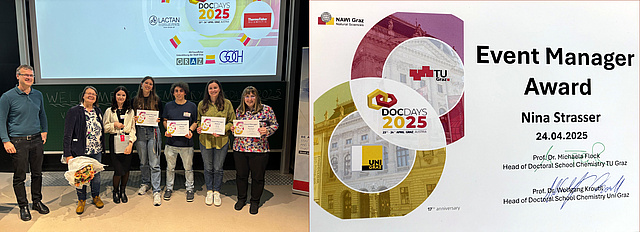

We welcome Daniel A Chaney (European Synchrotron Research Facility, Grenoble, France) with his presentation on
“Beyond the Braggs: Studying Disorder and Dynamics in Thin Films and Nanostructures with Synchrotron Light”.
Wednesday, April 9th, 2025, 11:15 AM
Venue: SR Solid State Physics (PH01150), Petersgasse 16, 1st floor, Graz University of Technology
Abstract: When searching for new materials to address the various technological challenges we face as a society it is well established that understanding the vibrational behaviour of atoms within a material, the so-called lattice dynamics, is of great importance. Furthermore, it is has become ever more apparent over the last decade that there exists a strong link between a material's functional properties with the presence of atomic scale disorder and the short-range correlations that exist within. To explore these two regimes as well as the coupling between them we operate two synergistic instruments at the ID28 beamline, ESRF, an inelastic x-ray scattering spectrometer to probe lattice dynamics and a diffuse x-ray scattering diffractometer to study correlated disorder.
In many cases thin film and nanostructured devices are at the forefront of our search for new material solutions and functionalities displaying properties that differ significantly from their bulk counterparts and providing access to additional tuning parameters including epitaxial strain, nanoscale dimensions, heterostructure design etc. Therefore, extending diffuse and inelastic scattering techniques to cover such systems is as vitally important as it is challenging. In this seminar I will detail the state of the art for ultra-low incidence angle diffuse and inelastic x-ray scattering as implemented at the ID28 beamline using a series of recent case studies. I will discuss the technical challenges, solutions and information that can be obtained through such studies.

We welcome Dr. Martin Presselt (Leibniz Institute for Photonic Technologies, Jena, Germany) with his invited presentation on “ Ultrathin functional layers from organized molecular dyes”.
Wednesday, July 8th, 2025, 11:15 AM
Venue: SR Chemie II (NT02128), Kopernikusgasse 24, 2nd floor, Graz University of Technology

Materials Project Partnering Day - Registration is open! Please register for our partnering event until January 7th, 2025.

Save the Date - Materials Project Partnering Day
Our (porous) material project partnering day will take place February 3rd, 2025 from 9AM to 5PM. We welcome interested researchers from the FoE Advanced Material Science and from the University of Graz.
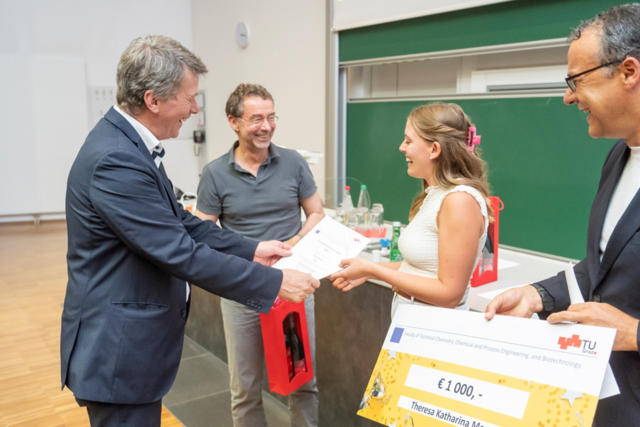

Nina Strasser received NA-XRD photo award
PMWS fellow Nina Strasser received the non-ambient XRD Photo Award for her contribution at the "XRD excites: Non-ambient XRD & Beyond International XRD Symposium 2024" in Graz. Congratulations, Nina!
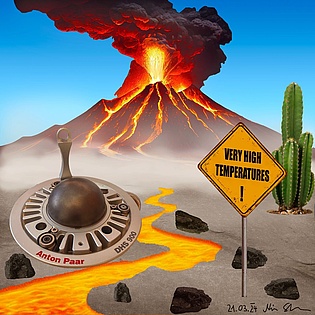
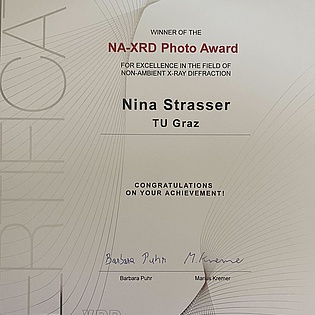

L’Oréal Austria stipend awarded to Caterina Czibula
Caterina Czibula (associate researcher in the PMWS project) is awarded a 2024 L’Oréal Austria stipend - Congratulations!
Her project HAIR MATTERS (HAIR Mechanics And Temperature Transitions Evaluated for single fibeRS) aims to shed light on hair mechanics and elucidate the effect of temperature on the mechanical behavior of human hair fibers. This project intends to study the mechanical properties of hair and gain new material insights by using an optical technique called Brillouin spectroscopy. Since this technique is non-contact, it allows for measurements in different directions of the same fiber to obtain comprehensive mechanical information. It also facilitates time-resolved studies of the impact of various treatments and environments on hair fibers. Human hair is an abundant resource that largely goes to waste due to limited and unexplored utilization pathways. Therefore, she hopes that by improving our understanding of hair mechanics, new pathways for its utilization will be created.
The PMWS project congratulates to this great success and wishes her all the best for this exciting research project!

We welcome Prof. Carlos Martí-Gastaldo (University of Valencia, Spain) with his invited presentation on “ Synthetic Control of Compositional Complexity in Reticular Frameworks”.
Thursday, July 4th, 2024, 10:30 hs
Venue: HS D (NT03034), Kopernikusgasse 24, 3.OG, Graz University of Technology
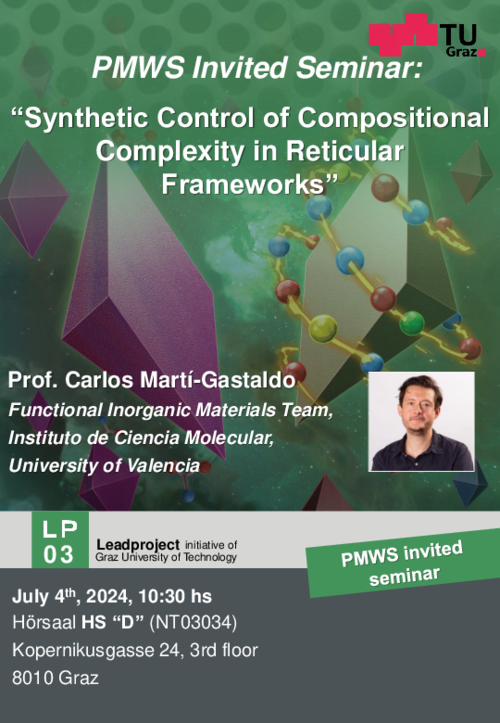

We welcome Prof. Weijin Li (Nanjing University of Science and Technology) and look forward to his talk “Energy conversion based on MOF materials under electric-/ electromagnetic field”.

We welcome Federico Rosei (University of Trieste, IT) with his invited lecture on
Functional Materials for Emerging Solar Technologies
Monday, April 8th, 2024, 15:00
Venue: HS H "Ulrich Santner", Kopernikusgasse 24, Graz University of Technology

Our PMW graduate Tomas Kamencek has been awarded his doctorate “sub auspiciis Preasidentis rei publicae”. He was awarded his certificate in the graduation ceremony on March 15th, 2024, in the presence of Governor Christopher Drexler and the rectors of the Graz University of Technolology, Horst Bischof, and the University of Graz, Peter Riedler, on 15 March 2024 and was presented the Ring of Honor by the Federal President at a reception in the Vienna Hofburg on March 18th.
Tomas, we congratulate you to this truly outstanding achievement!

Marie Skłodowska-Curie Postdoctoral Fellowship awarded to Miriam Velasquez
Miriam Velasquez (associate researcher in the PMWS project) received a Marie Skłodowska-Curie fellowship - Congratulations!
Her project FAST-MAP (Fast testing of multicomponent adsorption and diffusion in porous materials) aims to integrate microfabrication techniques with adsorption/diffusion studies to develop and validate a new technology for the rapid evaluation of multicomponent adsorption and diffusion in porous materials under industrially relevant conditions. This will contribute to the development of more efficient and cost-effective separation processes. The host of the fellowship will be the Ameloot Lab at KU Leuven.
The PMWS project congratulates to this great success and wishes her all the best for this exciting research project!
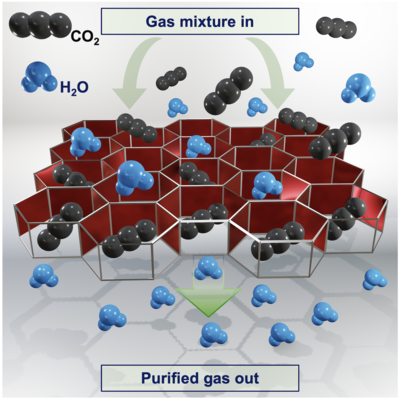

Margherita Aghito Received Best Speaker Award
Margherita Aghito received the Best Speaker Award for her talk "Magnetically responsive enzyme and hydrogen-bonded organic framework biocomposites for biocatalysis" at the Austrian Young Chemists Summit 2024 in Salzburg. Congratulations!

Florian Lindner received best presentation award and best poster award
PMWS fellow Florian Lindner received the Best Presentation Award for his contribution at the International BioBrillouin Society meeting 2023 in Dublin. He also received the Best Poster Award at the Exner Lectures 2023 in Vienna. Congratulations, Florian!
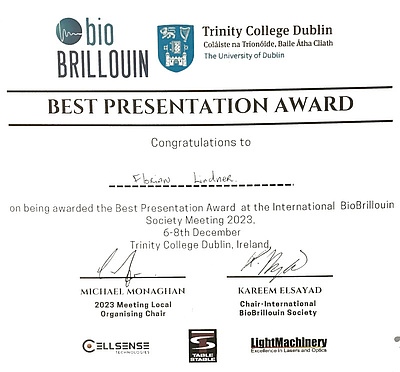

Fabrication of Oriented Polycrystalline MOF Superstructures
PMWS associate ECRs Mercedes Linares-Moreau, Miriam Velásquez-Hernández, Lea Brandner, Prof. Falcaro, and researchers from University of Vienna (Prof. Chin group), Catalan Institute of Nanoscience and Nanotechnology (Prof. Maspoch group), and The University of Adelaide (Prof. Doonan) have recently published an Invited Perspective article in Advanced Materials focused on emerging oriented MOF superstructures. The perspective examines the advantage, the challenges, and the recent fabrication approaches for the preparation of oriented polycrystalline MOF superstructures. While the advantage is the exploitation of anisotropic functional properties in MOF-based devices, the challenges include the need for customized self-assembly procedures to enable the precise orientation of each individual crystal. Colloidal assembly, external fields, heteroepitaxial ceramic-to-MOF, and other emerging methods are discussed. By covering nearly 300 articles, the perspective aims to provide a critical view of the field and promote the development of systems with oriented pore channels
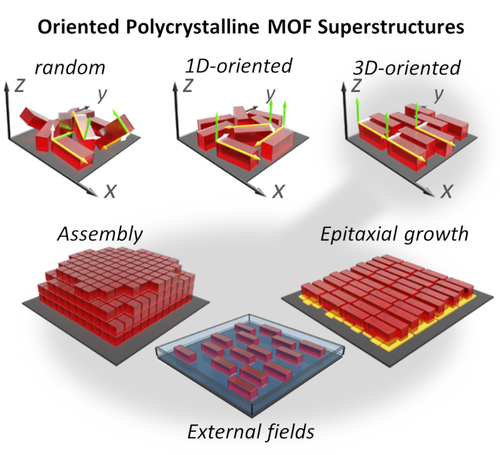

On February 14th, 2024, the 2nd μ-CT symposium is held at TU Graz. All interested in μ-CT are welcome.
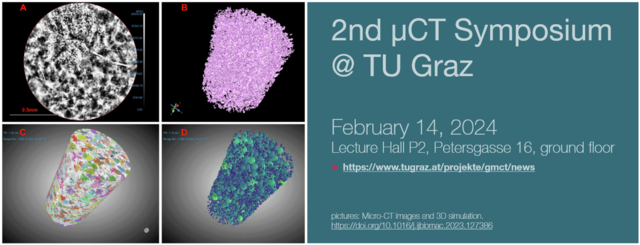

We welcome Tomoko Inose (Kyoto University) with his lecture on
Integration of photoinduced NO release MOF with plasmonic nanowire toward a novel platform for intracellular gas delivery
Tuesday, September 21, 2023, 15:30
Venue: HS M "Chemie", Kopernikusgasse 24, Graz University of Technology
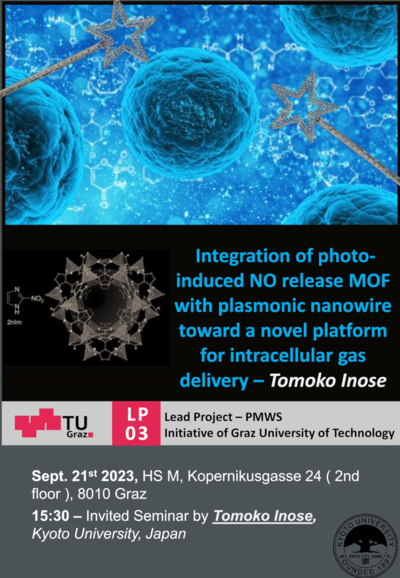

SEPT. 13TH-14TH: 2nd Annual PMWS Meeting in Semmering

Solution-Processable Cu3BiS3 Thin Films: Growth Process Insights and Increased Charge Generation Properties by Interface Modification
PMWS fellows Thomas Rath, Marco Sigl, and Heinz Amenitsch, together with researchers from Imperial College London (UK) and the MU Leoben (AT), present a a facile precursor-based method to prepare Cu3BiS3 thin films with an orthorhombic crystal structure on planar structures and mesoporous metal oxide scaffolds. Cu3BiS3 forms heterojunctions with such scaffolds. The article in ACS Appl. Mater. and Interfaces shows how Cu3BiS3 as part of such heterojunctions can serve as highly efficient, solution-processable, and inexpensive solar cell material.
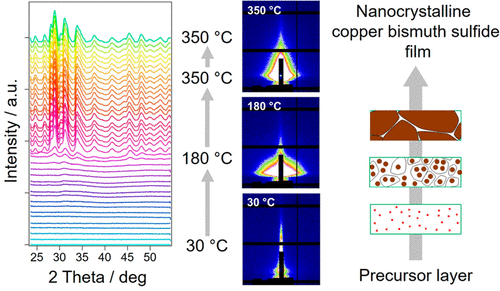

David Schuster received the WKO Forschungsstipendium 2022/23
David Schuster, master's degree student in Advanced Materials Science at TU Graz received one of the 20 Styrian chamber of commerce research-stipends (WKO Steiermark Forschungsstipendien) offered for excellent Master projects with particular relevance for the Styrian economy.
His master project is done in collaboration of TU Graz with Varta Innovation GmbH and strives for further advancing safety and reliability issues in Li-ion batteries. Nested in the TU Graz lead project "Porous Materials@Work for Sustainability", David strives for mitigating dendrite growth by using morphologically tailored porous carbon current collectors in solid-state batteries.
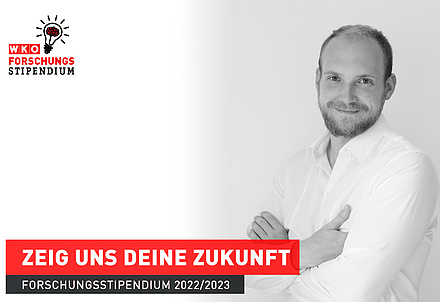

The 8th EPNOE International Polysaccharides Conference will be held at the Graz University of Technology from September 17-22 (2023). Our PMWS members Karin Stana Kleinschek (KR), Rupert Kargl (AR) and Konstantin Knaipp (P5) are active local organizers. Among others, the conference offers topics related to porous materials and hydrogels. The scientfic programme can be found here.
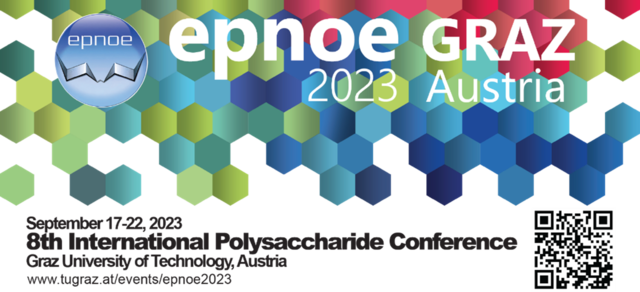

We welcome Christian Prehal (ETH Zürich) with his lecture on
Mesoscale phase transformations in beyond-intercalation-type batteries
Tuesday, June 13, 2023, 16:15
Venue: Lecture Hall P2, Petersgasse 16, Graz University of Technology

Save the date! We welcome Christian Doonan with his lecture on gas sorption on porous materials

Our first PMWS PhD Symposium will be held in May 2023.

Fabrication of 3D Oriented MOF Micropatterns with Anisotropic Fluorescent Properties
PMWS associate ECRs Miriam De Velásquez-Hernández, Mercedes Linares Moreau, and Francesco Carraro published together with an international team of reseachers from TU Graz, KU Leuven, U Friborg, and U Adalaide a MOF patterning protocol published in Advanced Materials that allows to immobilize and align fluorescent guest-molecules within the MOF pores. They used deep X-ray Lithography for the fabrication of 3D oriented MOF micro-patterns. MOF films with X-ray sensitivity were obtained by using a mixed linker strategy, integrating a brominated dicarboxylic ligand (Br2BDC) into a copper-based MOF Cu2L2DABCO (L=BDC/Br2BDC). The MOF film was obtained via heteroepitaxial growth from a sacrificial layer of oriented Cu(OH)2 nanobelts, thus affording 3D oriented MOF crystals. Immobilization and alignment of the fluorescent guest-molecules in the MOF pores is evidenced by rotating the polarization angle of the laser excitation in Fluorescence Microscopy. By controlling the functional response to light, this MOF patterning protocol could be used for the microfabrication of optical components for photonic devices.
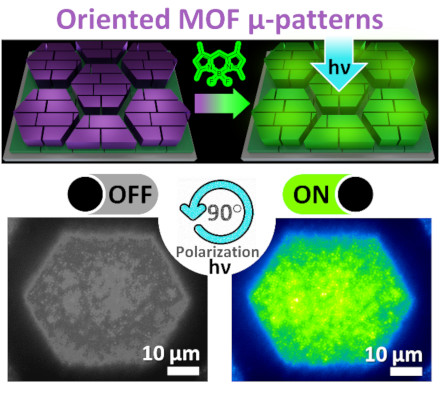

Tuning the surface properties of nanopores
Egbert Zojer, key researcher in Porous Materials@Work for Sustainability, disclosed how to tune the surface electronic structure of nanopores in covalent organic frameworks. The key idea is to decorate the pore surfaces with dipolar groups, which collectively lift or lower electronic states in energy at the pore surface and in the pore. The work is published in Nano Letters.
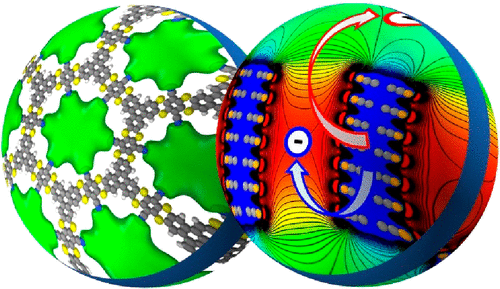

New copper isonicotinate polymorph in vapor-deposited thin films
Researchers from the KU Leuwen and from Porous Materials@Work for Sustainability revealed a new polymorph of a Copper Isonicotinate MOF, that is found in chemically vapor-deposited thin films. Crystalline order in such films is strongly influenced by the precursor layer. Their work published in Advanced Materials and Interfaces introduces how the combination of GIXRD data with Patterson functions can be used to identify the structure of an unknown thin-film MOF polymorph.
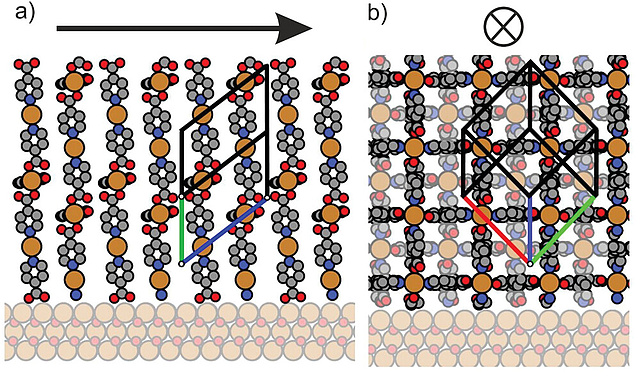

Making porous current collectors for batteries
Researchers from the National Institute of Chemistry Ljubljana, Varta Innovation GmbH and Porous Materials@Work for Sustainability disclosed a way of preparing conducting macroporous carbon coatings on conductive substrates. The work published in Monatshefte für Chemie is focusing on the preparation of poly(dicyclopentadiene) derived porous conductive coatings on metal foils and their scope and limitation when used as binder free current collector in lithium-sulfur cells.

Porphyrinic MOFs for oxygen sensing: Mirror, mirror on the wall, who's the most sensitive of them all?
A group of researchers from the Porous Materials@Work for Sustainability consortium uncovered the structure sensitivity relationship in porphyrinic zirconium-organic frameworks when used for optical oxygen sensing. The paper in ACS Applied Nano Materials establishes an oxygen sensitivity trend increasing in the order PCN-222 < PCN-223 < PCN-224. High sensitivity is above all caused by a maximized porphyrin−porphyrin separation in these nanostructured materials, which results in an increase of the fluorescence decay time, which, in turn, increases the probability of the quenching event. Defects in the nanostructure are another factor explaining variations in sensitivity within the same MOF type prepared with varying reaction conditions. Properly grown PCN-224 crystals show the highest sensitivity ever reported for a porphyrin based oxygen sensing material.
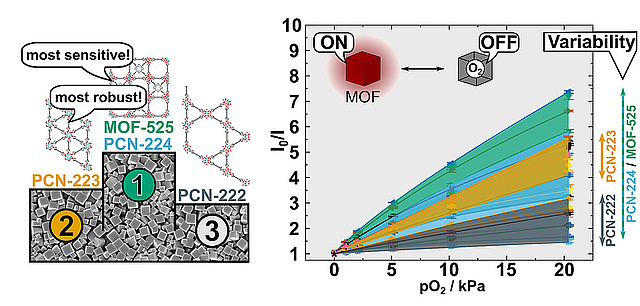

On the nanoscale structural evolution of solid discharge products in lithium-sulfur batteries using operando scattering
High-performance lithium-sulfur (Li2S) batteries with non-aqueous electrolyte solutions require a sound understanding of the conversion between Li-S and molecular surfur.
Researchers around C. Prehal, S. Freunberger, and V. Wood now demonstrate together with the PM@WS key researcher H. Amenitsch in their recent article that in-operando small-angle and wide-angle X-ray scattering and small-angle neutron scattering reveal how nucleation, growth and dissolution of solid deposits from atomic to sub-micron scales evolve during real-time Li-S cell operation.

A Free Web-App for the quantification of crystal phases in ZIF biocomposites
Depending on the preparation conditions, the addition of Zn cations and 2-methylimidazole to biomolecules often yields azolate frameworks bio-composites with different crystalline phases/topologies. PMWS associate ECRs Michael Hafner, Laura Villanova, and Francesco Carraro designed a free web-app that analyses XRD diffraction patterns. As outputs, the web-app 1) identifies the major crystalline components and 2) quantifies their amount. As zinc-based azolate frameworks with different crystalline phases have different functional properties, this web-app will facilitate the exploration and the design of MOF biocomposites with customized properties. The invited paper is part of a “New Talent 2022” themed collection on CrystEngComm (RSC). The web-app paper was highlighted with the front cover journal. See App-based quantification of crystal phases and amorphous content in ZIF biocomposites
Carbon foams from emulsion templated poly(dicyclopentadiene)
PM@WS researcher Christian Slugovc shows in his new article together with researchers from National Institute of Ljubljana, Varta Innovation GmbH, Institute of Science and Technology Austria and ICTM (TU Graz) that Ring-opening Metathesis Polymeriziation derived poly(dicyclopentadiene) foams are ideal precursors for the preparation of hierarchically porous carbon foams. The unique feature of the foams is that fixation necessary to retain the foam’s structure during the carbonization step is performed at very mild and sustainable conditions (oxygen from air, 40 °C). Upon carbonization foams with a carbon content higher than 97 %, an electronic conductivity of up to 2800 S·m–1, a Young’s modulus of up to 2.1 GPa, and a specific surface area of up to 1200 m2·g–1 were obtained. The 3D interconnectivity of the macroporous precursor foams was fully preserved and carbon foams with average void diameters between 87 and 2.5 μm can be prepared. Finally, the carbon foams were applied as porous cathodes for Li–O2 batteries. The favorable combination of active surface area and macropore sizes led to outstanding discharge capacities 10 fold higher than obtained with Super P based cathodes.

FWF project on nanoporous copper for biocatalytic applications
PM@WS aspring researcher Eva Maria Steyskal and key researcher Bernd Nidetzky secured an FWF grant CuBiC - nanoporous copper for biocatalytic applications. The Porous Materials@Work for sustainability consortium cordially congratulates for this great achievement and is looking forward to scientific cross-fertilization between their project and PMWS.
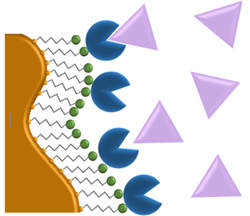

Sept. 26th-27th: PMWS started with kick off meeting
The researchers in the newly established team met at the Seegasthof Breineder. To use the momentum from the previous phase, key researchers gave a brief summary of the achievements of the previous phase followed by an introduction to their scientific interests and capabilities of their research groups. The aim of our 12 sub-projects were introduced during short presentations, in part already by the project-associated PhD students. Welcome aboard!
